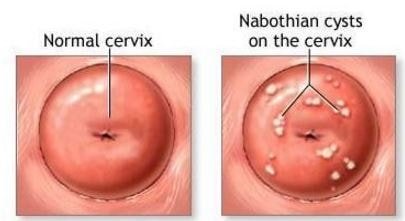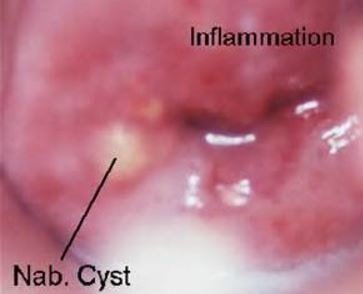Nabothian Cyst
What is a nabothian cyst?
Nabothian cyst develop on the exterior part of the cervix. The cervix is the connection between two major parts of the female reproductive system those are vagina and uterus. The cervix is a canal like structure and connected with cervical gland. The pale yellow colored mucous secreted by the cervical gland is filled with the nabothian cysts and also termed as mucinous retention cysts. These cysts are benign is nature and not create any serious health hazard.

Symptoms of nabothian cyst
The nabothian cyst is tiny bumps like structure with a usual diameter of 2 mm to 10 mm. But, they can even have 3 – 4 cm in diameter. In case of tiny structured nabothian cysts are usually asymptomatic. If the cyst size is more than 8 cm in diameter, then it has similar symptoms like cervical cancer or uterine tumor.
Large sized Nabothian cyst causes rectal or anal symptoms due to compression of the rectal region, as Nabothian cysts grow posteriorly. The included symptoms are pelvic congestion and dragging sensation.
During physical examination of pelvic, doctors usually noticed some smooth surfaced pale yellow colored bumps.
Causes
The cervix is made with columnar and squamous tissues and both the tissues are connected at the transformation zone. The transformation zone is continuously repaired and the cysts are developing due to repairing process of chronic cervicitis.
The gland orifice becomes blocked by inflammation and squamous metaplasia. The secretion from the endocervical columnar cells continues which accumulates and forms a mucinous retention cyst. The increased number of the Nabothian cyst causes in total enlargement of the cervix. Nobathian cyst also develop after child delivery or after mild injury.
Diagnosis
During physical examination of the pelvis, the usual findings are nabothian cyst and generally doctors considered it as normal findings.
If any unusual findings of cysts including enlarged size or exterior surface varied then doctors conduct colposcopy procedure, where magnifying instrument is used to close check up of the surface of the cervix. If this procedure gives some abnormal findings, then a biopsy is conducted. A small sectioned cut and test in the laboratory for examining the cancerous growth of the tissue.
- Pelvic ultrasound or cervical ultrasound also provides images which are clearly defined cystic lacerations close to the endocervical canal. The enlarged cervical region also indicates the cysts are large in size. Interrogation of the color Doppler provides no allied color flow, which also helps to understand that cyst is benign is nature.

- Pelvic MRI also may provide confined single or compound cystic lacerations within the cervical stroma.
- In CT scan, the tiny cyst may not be observable, but sporadically a focal low attenuation region may notice within the cervical region.
It has been observed that proper diagnosis can reduce the chances of misleading the diagnosis with uterine tumor or malignancy. This also helps in reduction of hysterectomy and complications associated with the surgery. The most well accepted diagnosis is colposcopy procedure followed by pelvic ultrasonography.
Treatment
Usually no treatment requires for nabothian cysts, as they are asymptomatic. In case of large sized cysts (more than 1 cm) avoidance of clinical treatment may cause discomfort and produce harmful effect. In this case, cysts removal is recommended by doctors.
The three methods which include excision, electrocautery ablation or cryotherapy are applicable for cysts removal. In the excision method, by using a scalpel or blade removal of excessive growth is conducted. In electrocautery ablation, electric current is applied for removal of the cyst.
The heat generated by the electric current is flowing over the cyst for removing purpose of the cyst. In cryotherapy, liquid nitrogen is used for freezes and shrinkage the cyst.
References
- Ultrasonographic Diagnosis and Treatment of a Giant Uterine Cervical Nabothian Cyst at http://www.jmu-online.com/article/S0929-6441(12)00057-4/fulltext
- Clinical presentation, Treatment and prognosis, Differential diagnosis, Radiographic features, Clinical presentation, Pathology at http://radiopaedia.org/articles/nabothian-cyst
- https://www.nlm.nih.gov/medlineplus/ency/article/001514.htm
- http://www.drugs.com/health-guide/nabothian-cysts.html
- http://www.healthline.com/health/nabothian-cyst#Causes2
- Abnormal Cervical Appearance: What to Do, When to Worry? at http://www.ncbi.nlm.nih.gov/pmc/articles/PMC3031439/
